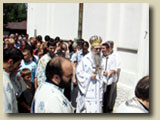| Information
Service of
the Serbian Orthodox Church
July
8, 2005

ST PETER’S DAYS OF SREBRENICA 2005
TO BE HELD FROM JULY 7-12
The Ministry of Labor and Protection for Veterans and Disabled
Persons in the Republika Srpska Government will once again be
the sponsor of an event organized by the Republika Srpska Veterans’
Organization and the Serbian Orthodox Church Parish of Srebrenica
in commemoration of Serbian civilians and soldiers from the Podrinje
region who perished during the course of the tragic conflict
in Bosnia and Herzegovina from 1992 to 1995.
The St Peter’s Days of Srebrenica 2005 will begin on July 7,
2005 in Bratunac with the opening of an exhibition of proposed
solutions for the memorial complex in Kravice and will go until
July 12, 2005, when the main memorial ceremony and religious
service for Serbs from Srebrenica, Bratunac and Milici who perished
will be held in the Military cemetery in Bratunac.
On the same day, His Grace Bishop Vasilije (Kacavenda) of Zvornik
and Tuzla will serve Holy Hierarchal Liturgy and a short memorial
service in the church of the Protection of the Most Holy Theotokos
in Srebrenica. After services His Grace will visit the massacred
Serbian villages of Biljaca and Zalezje, which were attacked
and destroyed on July 12, 1992, on the feast of St. Peter, by
Naser Oric’s forces. A spiritual academy is scheduled to be held
on the same day in the Culture Hall in Srebrenica.
During the course of the most recent war in Bosnia and Herzegovina
numerous crimes were committed. Just in the attacks by the armed
forces under the command of Naser Oric during the period from
May to December 1992, dozens of Serbian villages were ransacked
and destroyed and hundreds of civilians in the municipalities
of Srebrenica, Bratunac and Skelani were murdered in most brutal
fashion. Just on the territory of Srebrenica municipality 21
Serbian villages were attacked during this period and more than
400 civilians in them were killed; during the same period 22
Serbian villages in Bratunac municipalities were attacked and
at least 560 people were killed.
On Christmas Day, January 7, 1993, the unified armed forces
of the Srebrenica sub-region under the command of Naser Oric
attacked the Serbian villages on the territory of the local community
of Kravice in Bratunac municipality. In this attack on the villages
of Jezestice, Kajici, Siljkovici, Opravdici, Popovici, Mandici,
Banjevici, Ocenovici, Rustici, Dolovi and Jasikovaca 48 local
residents were killed, 14 of them inside their homes.
While the armed forces of the Srebrenica sub-region under Oric’s
command controlled this region, from March 7 to March 16, 1993,
688 households were destroyed and the Orthodox cemetery in Kravice
was desecrated.
In addition to Srebrenica and Bratunac municipalities, crimes
were also committed against the Serbian population in the municipalities
of Zvornik, Milici, Sekovici, Vlasenica and Osmaci. According
to available information on the immediate territory of this region
(Bratunac and Srebrenica municipalities) from 1992 to 1995 at
least 1,300 persons of Serbian nationality were murdered while
in the broader region of central Podrinje and Birce over 3,000
persons of Serbian nationality perished.
Republika Srpska institutions responsible for the investigation
of war crimes have been working on the investigation, collection
of evidence and documentation of war crimes committed against
Serbian civilians and soldiers in the Podrinje region from 1992
to 1995. This resulted in the issuance of an indictment for war
crimes against the war-time commander of this region, Naser Oric,
who is currently being tried by the International Criminal Tribunal
for ex-Yugoslavia in The Hague.
The activities of appropriate institutions for the investigation,
documentation and collection of evidence regarding crimes committed
against Serbs in the Podrinje region are ongoing and in parallel
with activities aimed at establishing war crimes committed in
other parts of Bosnia and Herzegovina, the purpose of which is
establishing the full and complete truth regarding crimes in
the most recent war, and bringing to justice those responsible
for committing crimes.
Source: www.vladars.net LIST OF SERBS WHO PERISHED IN SREBRENICA AND VICINITY,
1992-1995
LIST OF SERBS WHO PERISHED IN SARAJEVO, 1992-1995
LIST OF MISSING SERBS IN SARAJEVO, 1992-1995

FILM REGARDING CRIMES COMMITTED AGAINST SERBS On Saturday, July 9, 2005 at 12:00 noon a documentary film will
be shown in the large auditorium of the Sava Center regarding
crimes committed against Serbs during the wars that occurred
in the last decade of the twentieth century on the territory
of the former Yugoslavia.

RESTORATION OF RENEWED DORMITORY AND BELL TOWER OF MILESEVA
MONASTERY On the occasion of the consecration of the renewed dormitory
and bell tower of Mileseva Monastery, the Diocese of Mileseva
will be organizing a Spiritual Event on July 15 and 17, 2005
in the endowment of the Holy Dynasty of Nemanjic.
The first day of the event will begin at 5:00 p.m. with a wake
in the monastery church of the Ascension of Our Lord to be followed
by a people’s assembly in the monastery courtyard.
The Diocese of Mileseva and His Grace Bishop Filaret of Mileseva
have announced that His Holiness Serbian Patriarch Pavle will
serve Holy Hierarchal Liturgy with the concelebration of several
bishops from the homeland and abroad on July 16, 2005, the second
day of the church-people’s event, beginning at 9:00 a.m.
After Holy Hierarchal Liturgy His Holiness Patriarch Pavle will
consecrate the renewed dormitory and bell tower of the endowment
of the Holy King Vladislav followed by the serving of an atakist
(prayer) to St. Sava at 5:00 p.m.

METROPOLITAN AMFILOHIJE SERVES HOLY LITURGY AT LUSTICA On the feast of St. John His Eminence Metropolitan Amfilohije
of Montenegro and the Littoral served Holy Hierarchal Liturgy
in the monastery of Zanjica at Lustica
Speaking about the Nativity of St. John the Baptist as a divine
confirmation of fasting and prayer His Eminence emphasized in
a homily before the faithful gathered in the church at Zanjica
Monastery that “his birth through fasting and prayer is the confirmation
of something extremely important for our human life”.
“If we look a little more deeply at the history of the human
race and everything that has happened in it, we will see that
the greatest people were born from fasting and prayer. And not
only that but the most important events in the history of the
human race were born in fasting lands, that is, in deserts. Did
not the prophet and seer of God Moses see the face of God through
fasting and prayer, climbing on Mount Sinai? All great civilizations
of humanity and all its religions were born in deserts. In tamer
regions, in the fields and the wealthy lands these great thoughts
and ideas born in the deserts have merely been implemented. Whoever
has been to Greece, lived there and passed through there, will
see that the greatest wisdom of ancient times was in stone,”
said Metropolitan Amfilohije.
During the course of Holy Liturgy His Eminence ordained Petar
Bikar, a graduate of the Orthodox Theological Faculty of the
University in Belgrade, to the office of deacon.
Source: Svetigora Press - Z.K./M.R.

CHURCH IN BACKA PALANKA CELEBRATES ITS PATRONAL FEAST, THE NATIVITY
OF ST. JOHN THE FORE-RUNNER  On the feast of the Nativity of St. John the Fore-Runner (St.
John’s Day – Ivanjdan) His Grace Bishop Irinej of Backa served
Holy Hierarchal Liturgy in the church in Backa Palanka with the
concelebration of local clergy. On the feast of the Nativity of St. John the Fore-Runner (St.
John’s Day – Ivanjdan) His Grace Bishop Irinej of Backa served
Holy Hierarchal Liturgy in the church in Backa Palanka with the
concelebration of local clergy.
 Singing throughout the Holy Liturgy was by the St. John the
Baptist Choir from Back Palanka, a member of the Association
of Serbian Choirs. Singing throughout the Holy Liturgy was by the St. John the
Baptist Choir from Back Palanka, a member of the Association
of Serbian Choirs.
On that occasion Bishop Irinej congratulated the clergy, the
slava hosts, the candle-bearers and the faithful who gathered
on their church patronal feast. His Eminence then delivered as
homily explaining the meaning of this great Christian holiday
and pointing out all the dimensions of festal joy celebrated
on this day by the Church.
Deacon Branislav Mrkic

LETTERS OF ST SAVA OF CHILANDAR PRESENTED IN PRAGUE  A new book was recently presented in the embassy of Serbia and
Montenegro in Prague entitled “From Morava to Morava: From the
History of Czech-Serb Relations in the 19th and 20th Centuries”. A new book was recently presented in the embassy of Serbia and
Montenegro in Prague entitled “From Morava to Morava: From the
History of Czech-Serb Relations in the 19th and 20th Centuries”.
The book, a unique anthology of works documenting the development
of political, cultural, economic and spiritual ties between the
Czechs and the Serbs during the 19th and 20th centuries, was
issued by Matica Moravska from Brno in cooperation with Matica
Srpska in Novi Sad.
Speakers at the presentation included representatives of both
Maticas. Out of 12 works we select the contribution of Marcel
Cerni regarding the hitherto unknown correspondence between Father
Sava of Chilandar, who was of Czech origin (secular name Slavibor
Brejer) and then translator and propagator of Czech-Serb relations,
Jozef Rausar.
The manuscript of this correspondence is today a part of the
literary archives of the National Museum of Literature in Prague.
The author of the study sought to record some of the hitherto
unknown details regarding the visit of Sava of Chilandar to Serbia,
as well as the visit of Rausar to Chilandar Monastery.
Thirty-one letters were published which Rausar received from
Sava of Chilandar during the period of 1894 to 1911. Their content
is precious as an important source for a more recent history
of Chilandar, especially the period of the monastery’s transfer
from Bulgarian to Serbian administration. Especially noteworthy
is a letter from May 1896 describing in detail the formal visit
of King Alexander I Obrenovic to Chilandar Monastery at Easter
that year.

[Serbian
Translation Services]

Copyright © 1999-2004 by
The Information Service of the Serbian Orthodox Church
11000 Belgrade
Kralja Petra I no.5
+381 11 3282 596
e-mail
|

